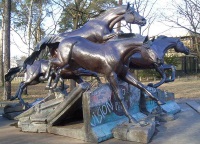
Occupying an abandoned movie theatre, the Allied Museum is located on the former US Army Europe's Berlin Brigade headquarters, and houses exhibits and displays detailing the history of the Allied forces in Germany in World War II and up until 1994. Three-quarters of the museum's collection was entrusted to Germany by the Allied forces when they departed after nearly 50 years of occupation. The museum's collections include all kinds of military memorabilia: airplanes and motor vehicles, weapons, uniforms, documents and files, photos and other artefacts, including the original Checkpoint Charlie shed.The permanent collection has three main sections. The end of the war and the famous Berlin Airlift are covered in the exhibition on the years 1945 to 1950. An outdoor exhibition featuring large artefacts like planes and sections of the Berlin wall illustrates the history of West Berlin as an island in the Soviet zone. A permanent exhibition on the years between 1951 and 1994 covers Germany's experience of the Cold War. The museum also organises periodic events like lectures and film screenings, as well as special, temporary exhibitions - check the website for specific dates.
Address : Clayallee 135 - Outpost
Website : www.alliiertenmuseum.de
Telephone : (030) 81 81 99 0
Transport : S-Bahn: S 1 to Zehlendorf, then take Bus No. 115 (direction U-Güntzelstr.) or No. X83 to AlliiertenMuseum. U-Bahn: U 3 to Oskar-Helene-Heim. Bus: No. 115 or No. X83 to AlliiertenMuseum.
Opening times : Daily 10am to 6pm; closed Mondays.
Admission : Free

Since opening in 2001, the Berlin Jewish Museum in Lindenstrasse has gained an international reputation for its significant architecture and unique exhibitions that bring history to life. The bulk of the museum is housed in a windowless and doorless steel-clad, silver building, designed by Daniel Libeskind, situated alongside the yellow Baroque edifice of the Berlin Museum. The building is remarkable and designed to be intimidating. Visitors enter the Jewish Museum through the Berlin Museum to explore the exhibition rooms, which are clustered around a main axis void, designed to signify the empty and invisible aspects of Jewish history. The whole museum is beautifully designed and the exhibitions can be quite overwhelming emotionally, although this is to be expected for a museum showcasing such tragic history. The collection is a good mix between personal stories and mementos and more formal history; it is also quite interactive. The collection is extensive and will require at least a few hours to see in its entirety, particularly as the gardens are also worth a stroll.
Address : Lindenstrasse 9-14
Website : www.juedisches-museum-berlin.de
Telephone : (0)30 2599 3300
Transport : U1, U6 to Hallesches Tor or U6 to Kochstraße
Opening times : Monday 10am to 10pm; Tuesday to Sunday 10am to 8pm.
Admission : €8 (adults); €3 (reduced).
The remains of the infamous Berlin Wall have now become the largest open-air art gallery in the world. The longest section of the wall, which has been preserved, stretches from Ostbahnhof station to the Oberbaumbrucke, and has been given over to graffiti artists from around the world. About 118 artists from 21 countries have demonstrated their skills on the 4,318 foot (1,316m) long section of the wall, and this collection has become a Berlin landmark and a tourist attraction. Some of the best known paintings are Dimitri Vrubel's 'Brotherly Kiss' and Gunther Shaefer's 'Fatherland'. The gallery is billed as an international memorial for freedom and the art reflects the idealism and excitement of 1989 and 1990 when the wall was pulled down.Parts of the wall have been or are being restored to reverse the damage done by time, weather and vandals because some of the once colourful murals created in 1989 and 1990 are now very faded. The images are restored in most cases by the original artists themselves and this ongoing project of restoration is special in itself because it keeps the wall alive in the public imagination.
Address : Mühlenstraße
Website : www.eastsidegallery-berlin.de
Admission : Free
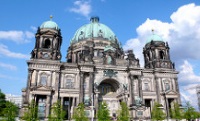
The Berlin Cathedral was built between 1895 and 1905 and is a magnificent basilica that stands on the site of several earlier structures. It is the largest church in the city and is an active Protestant church that holds services, concerts and tours as well as a number of other events. Inside, the crypt contains over 80 sarcophagi of Prussian royals, while other areas of interest are the pulpit, the organ, and the stained glass windows. Visitors can climb the dome, which is decorated with intricate mosaics. The cathedral has a gift shop with books, CDs, and other souvenirs available. The cathedral is closed to tourists during religious services and visitors are asked to be respectful in the place of worship at all times. Guided tours are available and there are good-quality audio guides in multiple languages for hire.
Address : Am Lustgarten, Museum Island
Website : www.berlinerdom.de
Transport : S-bahn and U-bahn to Alexanderplatz; bus 100, 157 or 348; tram 2, 3, 4, 5, 6, 15 or 53
Opening times : Opening times vary day to day and the church is sometimes closed for services or events - check the website for opening times.
Admission : €7 (adults), €5 (reduced). Audio guide: €3.
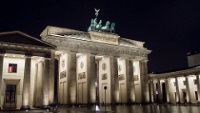
The impressive and symbolic Brandenburg Gate that lay forlorn for so long in the no man's land behind the Berlin Wall, is now once again renovated and accessible, along with the newly reconstructed Pariser Platz that links the gate to the beautiful Unter den Linden Boulevard. The Brandenburg is Berlin's only remaining city gate, built of sandstone between 1788 and 1791, with 12 Doric columns according to a design by C.G. Langhans. Six columns support a 36-foot (11m) transverse beam, similar to the propylaeum of the Acropolis in Athens. The massive gate is topped with a stunning statue of the Goddess of Victory facing east towards the city centre, which was added in 1794. The gate is closed to traffic, as is the adjacent Pariser Platz, a gracious square that was once surrounded with beautiful buildings sadly destroyed in the Second World War. Since the fall of the Berlin Wall new buildings have been built to designs closely following those of the originals.It is easy to hire a guide for the area and it is worthwhile because the Brandenburg Gate has an intriguing history and a special place in the German culture. Hearing about its significance and past from a local greatly enriches the visit.
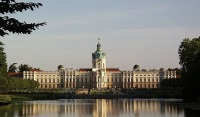
Schloss Charlottenburg is the largest and oldest palace in Berlin. The 18th-century Baroque structure was originally constructed as the summer home for Sophie Charlotte, the wife of Elector Frederick III who became the first Prussian king. The splendid interiors are festooned with art masterpieces, including the largest collection of 18th-century French paintings anywhere outside of France. The surrounding gardens contain a mausoleum, pavilion and the Belvedere, which houses the porcelain museum. For centuries the best artists, architects and landscapers were commissioned to improve and enrich the palace and it shows. The gardens are lovely and just as worthwhile in their own way as the palace itself. Like many attractions in Berlin, the Charlottenburg Palace was badly damaged in World War II but has since been reconstructed.Although it is a fairly long walk from the train station it is worth doing if you can manage it because your first view of the palace over the lake is really striking.
Address : Spandauer Damm 10-22
Website : www.spsg.de
Telephone : (0)3 319 694 200
Transport : U2 or bus 309 to Sophie-Charlotte-Platz
Opening times : 10am to 6pm (April to October) and 10am to 5pm (November to March); closed Mondays.
Admission : Combined ticket for Charlottenburg: €15 (adults); €11 (reduced).
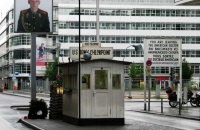
The infamous border crossing point in the wall dividing West and East Berlin has now become a shrine to the wall's memory with the addition of a museum, Haus am Checkpoint Charlie. For nearly three decades, between 1961 and 1990, Checkpoint Charlie in the Friedrichstrasse was the only crossing point between East and West Berlin. While the original metal shed is now on display at the Allied Museum, the soldier's post can be visited, and tourists can be photographed under the border sign. The museum's permanent exhibition dates back to the building of the Berlin Wall, and charts the lifespan of the wall, including its erection, its demolition and an intriguing collection of objects used to escape over, under, and through it, and the stories of those escapees who risked their lives to win their freedom. The museum is also generally concerned with human rights. The Checkpoint Charlie Museum houses temporary exhibits, and hosts lectures and film screenings; check the website for schedules.
Address : Friedrichstraße 43-45
Website : www.mauermuseum.de
Telephone : (030) 253 725-0
Transport : U-Bahn - U6 (Kochstraße) or U2 (Stadtmitte); Bus - M29 (Kochstraße) or M48 (Stadtmitte)
Opening times : Daily 9am to 10pm.
Admission : €12.50 (adults), €9.50 (students), €6.50 (under 18s), free for children under 6. Other concessions available.
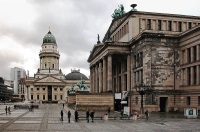
Said to be one of the most beautiful squares in Europe, the Gendarmenmarkt is certainly one of the most impressive in Berlin, created as a marketplace in the 17th century. During World War II most of the buildings surrounding the square were destroyed, but have since been reconstructed and returned to their former glory. The square is dominated by the beautiful Konzerthaus (concert house), which is home to the Berlin Symphony Orchestra, and a special place to catch a performance. The other famous buildings on the square are the twin churches of Deutscher Dom and Franzosischer Dom, identical German and French cathedrals, which are well worth a visit.The square stays busy even in winter, when Gendarmenmarkt is host to Berlin's best Christmas market and various concerts. Surrounding the plaza are a number of cafes and restaurants where visitors can rest their feet and get a good view of passers-by. It is a popular area for locals to enjoy their lunch breaks. There are usually musicians performing in the square as well which adds to the atmosphere. The Gendarmenmarkt is also really lovely at night, when the buildings are illuminated.
Transport : Bus N6 or U-bahn U2 and U6
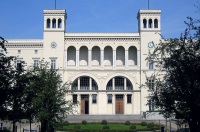
One of the most popular art galleries in Berlin is housed in a former train station. The historic Hamburger Bahnhof, built in 1846 at the Tiergarten, was badly damaged during World War II, but has been restored and reopened as an exhibition venue for an extensive contemporary art collection. The former station now offers 107,639 square feet (10,000 sq metres) of space filled with works by the likes of Andy Warhol, Josephy Beuys and Roy Lichtenstein. The basis of the exhibition is the Marx private collection, but there are changing exhibitions and good examples of the Italian Transavanguardia and minimalist art on show too. The gallery holds regular free guided tours for the public. To find out when these are being conducted consult the 'events' section of the website.
Address : Invalidenstraße 50- 51
Website : www.smb.museum/en/museums-institutions/hamburger-bahnhof
Telephone : (0)30 397834-11
Transport : U6 to Zinnowitzer St.; tram M6, M8 or 12; S3, S5, S7, S9, S75 to Hauptbahnhof
Opening times : Closed Mondays; Tuesday, Wednesday and Friday open 10am to 6pm, Thursday open 10am to 8pm, Saturday and Sunday open 11am to 6pm.
Admission : €14 (adults); €7 (reduced); children under 16 free. Concessions available.
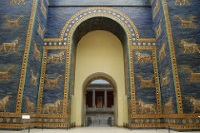
The huge Pergamon Museum has three main departments: the Antiquity Collection, the Islamic Art Museum, and the Middle East Museum, that house parts of reconstructed monumental buildings transported from excavation sites in foreign lands, or faithful replicas thereof. The Antiquity Collection contains the Pergamon Altar from the second century BC, as well as the Market Gate of Miletus from Roman antiquity. The main attraction in the Islamic Art Museum is the Mshatta façade originating from a Jordanian desert palace. The Middle East Museum houses the Ishtar Gare and the Procession Way of Babylon, as well as the throne room façade of Nebuchadnezzar II.This museum is consistently ranked by visitors as one of the top attractions in Berlin and it is extremely special to visit all the ancient sites preserved in its halls. Everything feels enormous and although many of the exhibits feature reconstructions rather than originals everything feels extremely authentic. There is a free audio guide available which is hugely informative.
Address : Am Kupfergraben 5, Museum Island
Website : www.smb.spk-berlin.de
Transport : U-Bahn and S-Bahn to Friedrichstrasse; tram M1, M4, M5, M6, or 12; bus 100, 200 or 147
Opening times : Daily 10am to 6pm, until 8pm on Thursday.
Admission : €12 (adults), €6 (reduced).
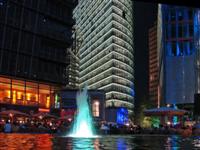
Potsdamer Platz is the heart and soul of the 'New Berlin', which has emerged since the fall of the wall in 1989. The original square was once one of the busiest junctions in Europe, with a major train station situated on it. However, after damage during the Second World War and being cut through by the divisive wall, it became a decayed wasteland. Since the fall of the wall, however, a building boom has been taking place around the Potsdamer Platz. The square now plays host to an exciting mix of restaurants, shopping centres, hotels, a casino, theatres and cinemas that draws both Berliners and tourists seeking good food and recreation.The focus of the square is the 22-storey Debis Haus, designed by Renzo Piano, featuring an atrium with cathedral-like dimensions, and its neighbouring Potsdamer Platz Arkaden, a shopping mall with an Imax cinema. The Sony Centre is the most recent addition, consisting of seven buildings around a light-flooded arena, which also houses Berlin's popular Film Museum. The Kollhoff building features a panorama platform, reached by Europe's fastest express elevator, which offers views of the city.
Website : www.potsdamerplatz.de
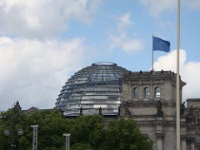
The Reichstag is one of Berlin's most famous buildings. The seat of Germany's parliament since 1894, the building has had a volatile history, being damaged in World War II, wrapped in a sheet by conceptual artist Christo in 1995, and massively reconstructed in the late 1990s. The reconstruction saw the building gutted, leaving only the facade, and the addition of a glass-domed atrium that provides panoramic views of Berlin. The views from the dome are stunning and it is well worth the visit.Note that although entrance is free the rooftop terrace and dome of the Reichstag are closed to visitors without pre-booking. There is an Arts and Architecture tour or a general tour of the Reichstag (if Parliament is not in session) available and you must contact the Reichstag directly and request a visit. Although the office is helpful there are thousands of people making this request so make sure you plan in advance (six months as a guideline) to avoid disappointment. There are free audio tapes available in a number of languages. There is also a rooftop restaurant which is very popular but for this too you will need a reservation.
Address : Platz der Republik 1
Website : www.bundestag.de/kulturundgeschichte/architektur/reichstag
Telephone : 030 22 73 21 52
Opening times : Daily 8am to midnight.
Admission : Free
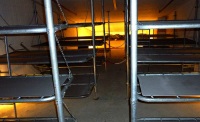
One of Berlin's most popular attractions, this unusual exhibition recounts the history of the German capital city from its foundation until the fall of the Wall in 1989. The Story of Berlin is divided into 25 themed rooms and pays attention to the feelings, thoughts and living conditions of common Berliners. The museum is impressively well designed and compelling with modern multimedia technology in every room and a good mix of historical fact and more personal, anecdotal detail. History buffs may be disappointed that the exhibits don't go into more detail but the museum covers about 800 years of history and is understandably superficial in some respects. Its strength is the recreation of atmosphere and mood in different eras and its visual representation of each period. One of its main attractions is the nuclear bunker that was built during the Cold War in the 1970s and the admission price includes a guided tour through this nuclear bomb shelter. Guided tours are available every hour, starting in the foyer.
Address : Kurfürstendamm 207-208
Website : www.story-of-berlin.de
Telephone : (0)30 887 20 100
Transport : Subway to Uhlandstrasse or Kurfürstendamm, S-Bahn to Savignyplatz or Zoologischer Garten, or bus to Uhlandstrasse
Opening times : Open daily 10am to 8pm. No entry after 6pm, which is when the last guided tour starts.
Admission : €12 (adults), €9 (reduced). Other concessions available.

Travel Guide powered by Word Travels, copyright © 2023 Globe Media Ltd. By its very nature information in this travel guide is subject to change at short notice and travellers are urged to verify information on which they're relying with the relevant authorities. Neither Globe Media Ltd nor Travel Vogue can accept any responsibility for any loss or inconvenience to any person as a result of information contained above.